Design of a Communication Device of Infrared Thermal Imaging Target Recognition and Tracking System
Abstract
Due to the presence of solar radiation, each object emits electromagnetic waves at different temperatures. Thermal infrared imaging is to image an object through a thermal infrared CCD, which can reflect the temperature field of the object. The image information is obtained by infrared radiation intensity distribution, and the infrared light invisible to the human eye is converted into a visible image. Thermal infrared has a wide range of applications in military, industrial, automotive, medical, and other fields. This technology is still a research hotspot at present, and it has high research value for any region. This paper designs a communication device architecture for an infrared thermal imaging target recognition and tracking system and optimizes and compares different target recognition and tracking algorithms. The test results show that the device system can reduce the system software frame processing time from 120 ms to an average of 28 ms, and the processing speed is increased by about 4.3 times.
1. Introduction
1.1. Background
So far, infrared thermal imaging is still the focus and hotspot in the technical field of all countries in the world, and it occupies a very high position in the scientific and technological strategies and military strategies of all countries in the world. A variety of strategic technologies are closely related to infrared thermal imaging technology, which can achieve night operations and precise tracking of target objects. In recent years, the research of infrared technology has developed rapidly. From the patient's temperature detection in the hospital to the military intelligent early warning system, there are infrared figures.
The working principle of the infrared imaging system is to limit vision to the range of light and spectral response and to expand the visual function of the human eye. It does not need external light source illumination, so it can work all day, and the infrared imaging system is passive imaging, so it has good concealment. Because the infrared imaging system works in the long wavelength range, it has stronger smoking performance than visible light radiation. Therefore, the infrared imaging system has long-distance and strong anti-interference ability.
Infrared communication has the characteristics of simple control, practical implementation, and high transmission reliability. It is a commonly used method of communication. It is widely used in infrared thermal imaging cameras, infrared cameras, infrared spectrometers, and other fields.
1.2. Significance
In addition to military applications, thermal imaging target recognition and tracking technology is also widely used in road safety, medical observation, autonomous driving, and intelligent assistance systems. Although infrared technology has many advantages, it also has its limitations. Compared with visible light imaging, infrared imaging systems lack certain characteristics of the image. It only has grayscale information, and infrared imaging is absorbed by air, and the edges of the image are blurred. The communication device that optimizes the infrared thermal imaging target recognition and tracking system is to denoise and enhance the infrared image through the enhancement of the function of the digital signal processing unit, suppress noise, and highlight the target. Therefore, this subject has certain practical significance.
1.3. Related Work
Jiang studied target recognition and tracking in a series of images, and he proposed a general target tracking framework. In this framework, Jiang uses image frames to generate positive and negative samples to train the classifier and uses the classifier to distinguish between the target and the background. He also uses a set of weak classifiers to construct a strong classifier. Experiments show that the precision and recall of this method on the two public data sets are better than the related work [1]. His experiment process is still more complicated and costly. Dey M K proposed the design and implementation of an automatic multisensor wireless security system to provide realtime monitoring and alarm. The amoeba structure and functional capabilities of the system make it possible to be used as an advanced security layer, home automation, and industrial monitoring. It is used to protect areas where human contact is restricted. Human body detection is realized by using a HCSR501 passive infrared sensor interfaced with a ATMEGA328P microcontroller [2]. The system structure is not mature enough. Yi-Fan has conducted research on photodetectors, which convert light signals into current signals. The I–V converter amplifies the input current signal and converts it into a voltage signal, which is then processed by a variable gain amplifier (VGA) and a band pass filter (BPF). The driven transistor provides a digital signal to the microcontroller or other device for further processing [3]. His research is meaningful, but his experiments are geared toward visible light rather than infrared imaging. Bora A J reported on the design of a low-cost, field-portable compact optical system based on smart phones. The system is suitable for visible light (VIS)-near infrared (NIR) spectral region. Using the Universal Serial Bus on the go protocol, the battery of the smartphone is used to power the external light-emitting diode, and its ambient light sensor (ALS) is used as a photodetector [4]. The accuracy of system recognition in his research is not very satisfactory. In order to solve the challenge of maintaining the connection between the mobile device and the light source in the direction of light in a mobile environment. Xiong J uses optical positioning to assist the switching process. In the positioning phase, the network manager obtains the location information of the user equipment through the downlink and uplink signal strength information, which are white light and infrared light, respectively. Then, the Kalman filter is used to improve the tracking performance of mobile devices [5]. Wang X uses correlated filter trackers and deep learning detection methods to achieve accurate tracking results. The ratio of the average peak correlation energy (APCE) introduced in the current frame to the average APCE of the previous frame is used as the criterion for updating the UTA-CF tracker to maintain the stability of the target model. Moreover, he combined the nearest neighbor maximum method and APCE criterion to initialize the YOLOv3 re-detector. Experimental results show that this method has significantly improved tracking accuracy and robustness [6]. However, his research algorithm is more complicated and the operation is not easy. In response to the extensive application requirements of airborne optoelectronic systems, Ding M has conducted research on the detection and recognition of infrared targets. The algorithm can be divided into three parts. First, he proposed a candidate area detection method for infrared image target recognition. Second, in order to extract the features of each candidate region, he proposed a local descriptor and then used a simple linear classifier to further complete the target recognition. Finally, he transplanted the detection and recognition algorithm to the embedded platform [7]. Hatem HR uses protues software to simulate and implement the voice communication system. Using infrared as the light source, a kind of audio communication (a link to transmit and receive voice and music through infrared light) is established. The result of this work is the design and implementation of an optical wireless system that transmits voice over a certain distance in the laboratory. This system has many advantages, such as general purpose, low price, and minimal interference [8]. However, the specific effects and feasibility need to be further studied. Their results have brought different inspirations to the research of this article, especially in the selection of algorithms, the performance, and cost control of system device design.
1.4. Innovation
Infrared thermal imaging target recognition and tracking technology has a wide range of application prospects and huge application value. Advances in various technologies have promoted the latest developments in infrared thermal imaging communication devices. The innovations of this paper are mainly as follows: (1) Innovation of infrared thermal imaging communication device system: It is different from the commonly used dual DSP processing system. This paper designs a hardware system with FPAG high-performance processor + dual DSP for real-time signal processing. It greatly improves the performance of the system, reduces the time delay, and increases the system frame processing speed by 4.3 times. (2) Recognition and tracking algorithm innovation: The article reviews the recognition and tracking algorithm. In the experiment, the optimized SVM algorithm and the fusion PF-KCF filter algorithm were tested for performance. The results prove that the two algorithms in this paper are superior to other algorithms of the same type. Among them, the sample classification error rate of SVM is only 0.024 when the objective cost is high.
2. Design Method of Communication Device of Infrared Thermal Imaging Target Recognition and Tracking System
2.1. Infrared Thermal Imaging Technology
Infrared thermal imaging detection includes several stages. It generally includes effective acquisition of target objects, segmentation of recognized objects, extraction of effective features, and final classification, recognition, and tracking. Those steps are closely related. In order to achieve the purpose of detection, the accuracy and speed of infrared thermal imaging to determine the target should be ensured and the best processing result will be obtained. It is necessary to improve the main technical algorithm of each link [9].
2.1.1. Adaptive Infrared Image Histogram Equalization Algorithm
The e parameter plays a leading role in the algorithm. The larger the e, the less obvious the maximum contact value. The weighting function mapping function diagram is shown in Figure 1. It can be seen from the graph that the main background peak of the original image is very weak, and there is no change in other parts.

2.1.2. Infrared Thermal Imaging Filtering Algorithm
In the process of target recognition, due to its own characteristics, infrared imaging technology is still far behind the imaging effect of visible light images. The acquired image may be difficult to extract edge blur information or have a lot of noise [12]. Noise will affect the recognition effect. It is a meaningless signal component in the recognition process and will bring unnecessary errors. Therefore, it is a necessary procedure to filter and denoise infrared thermal imaging images.
2.1.3. Smooth Filtering and Denoising
2.1.4. Median Filtering Algorithm
2.1.5. Image Segmentation Clustering Segmentation Algorithm
The K-means algorithm is to determine the optimal partition by minimizing the function P. Given the division of the sample set, when takes the mean of Qi, P can be the smallest [16]. The algorithm process is to select the initial class mean of K given samples, and then automatically select the classes according to the minimum distance. In this way, the image is divided according to the minimum distance of the mean.
2.1.6. HOG Feature Extraction
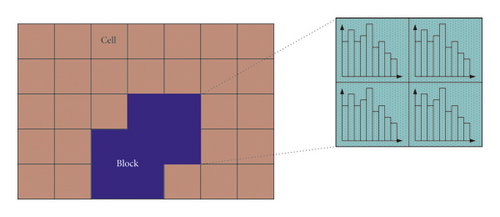
For infrared thermal imaging, a very important point is not the applicability of the algorithm, but to improve the extraction of clear edge information and reduce the recognition error rate. In a comprehensive comparison, HOG feature extraction most meets the requirements of this experimental research.
2.2. Infrared Thermal Imaging Target Recognition and Tracking
2.2.1. Infrared Thermal Imaging Target Recognition Algorithm
Infrared target recognition and tracking is an important research branch of pattern recognition, and it is widely used in automation, video surveillance, display enhancement, and other fields. As an important research content of machine learning, it has always been a research hotspot. Many excellent algorithms have been proposed and applied in practice. In target recognition and tracking algorithms, the recognition rate of the algorithm and the real-time and stability of the tracker are still important areas of research [18]. The basic principles and evaluation criteria of two commonly used recognition algorithms are introduced.
(1)SVM Target Recognition. A SVM classifier is proposed based on linear separable optimal classification. It is similar to a neural network, with good generalization ability, easy to expand, high target recognition efficiency, and can improve the classification ability of nonlinear samples by mapping the low-dimensional feature vector to the high-dimensional space through a suitable kernel function. The common kernel functions of SVM include the Gaussian kernel function, q-order polynomial kernel function, and multilayer Sigmoid kernel function. The kernel function conversion is shown in Figure 3.

Its classification principle is to separate two types of samples by adjusting the linear function parameters. When the linear function can completely separate the two types of data samples, the function equation is the optimal linear hyperplane [19]. When the data sample cannot find the corresponding linear hyperplane, the linear hyperplane with the lowest cost will be found by training the classifier.
The mean shift algorithm based on the difference model refers to the weighted processing of the image pixel values after the difference is used for all pixels in the area. Tables 1 and 2 show the pixel value of each point in the original image and the pixel value after the difference. After the mean shift algorithm, the gray value difference between the pixels in the area is significantly greater. However, the real-time performance of the mean shift algorithm for target tracking needs further research.
| Pixel value | y1 | y2 | y3 | y4 | y5 |
|---|---|---|---|---|---|
| y1 | 43.004 | 51.089 | 68.001 | 76.431 | 81.530 |
| y2 | 52.431 | 63.620 | 65.487 | 74.340 | 80.675 |
| y3 | 59.389 | 69.607 | 76.509 | 78.562 | 76.326 |
| y4 | 63.451 | 67.530 | 71.007 | 74.083 | 71.654 |
| y5 | 64.079 | 67.004 | 68.658 | 73.067 | 70.872 |
| Pixel value | y1 | y2 | y3 | y4 | y5 |
|---|---|---|---|---|---|
| y1 | 43.004 | 51.089 | 39.859 | 76.431 | 81.530 |
| y2 | 52.431 | 30.317 | 69.300 | 101 | 80.675 |
| y3 | 1 | 8.961 | 51.203 | 59.230 | 68.336 |
| y4 | 63.451 | 37.212 | 48.618 | 65.365 | 71.654 |
| y5 | 64.079 | 67.004 | 48.504 | 73.067 | 70.872 |
The pixel value of the center area is the blue font part, called area A, which is the area with the Euclidean distance from the center d less than 3. Table 2 shows the difference model for area A. The specific steps are as follows: first make the difference c between the maximum pixel value and the minimum value among all points in the area A. Second, the pixel values of all points in the area are summed with the quantized value of the previous step. Then, the difference is made with the minimum value of the original pixels of all points, and finally, the difference is further quantified.
2.2.2. Infrared Image Enhancement Algorithm
Image enhancement algorithms can be divided into spatial domain processing, time domain processing, transform domain processing, and so on. Image enhancement plays an important role in highlighting the region of interest in image processing. It can enhance the useful information in the image and suppress meaningless information [21–23]. This article mainly introduces point processing enhancement, which is a method of spatial domain processing [24].
The adaptive piecewise linear algorithm is to first find the grayscale most frequent value and the corresponding frequency from the histogram, and then traverse from the 0 grayscale to the right until it finds dk. Then, traverse to the left from the 255 gray level of the histogram until dR is found. Then, according to the look-up table established by formula (19), the original image is transformed into grayscale [27, 28].
2.3. Infrared Imaging Target Recognition and Tracking Communication Device System Scheme
2.3.1. Infrared Thermal Imaging Target Recognition and Tracking System
When the infrared thermal imaging system is working, the infrared radiation pattern formed by the target and the background should be transferred. When it comes to the optical system, it will focus on the photosensitive device. At the same time, the temperature sensor detects the target temperature and transmits it to the infrared transmitter. After the system sends out a one-dimensional video signal according to time, the signal is loaded into the digital signal processing circuit after analog circuit and AD conversion. The circuit can synchronize the transmitted signal in real time, with strong anti-interference ability, and finally, the image signal enters the display. The system principle diagram is shown as in Figure 4, it is made up of a transmitting device, transit node, and receiving device.

2.3.2. Composition of the Infrared Thermal Imaging Communication System
The commonly used infrared communication system is an image target recognition and tracking system based on a DSP platform. With infrared light as the carrier, thermal infrared CCD, PWM modulation technology, and Manchester encoding method are used to realize the real-time transmission of thermal imaging temperature signals. Another algorithm can be selected to realize the programmable multifunction in the tracking system. The system schematic diagram is shown as in Figure 5.
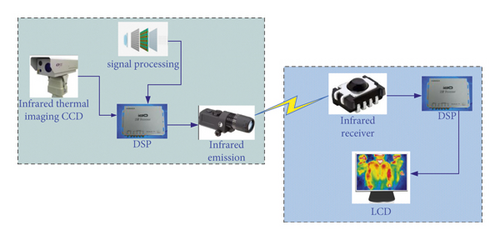
3. Experiment and Analysis
3.1. Design of Infrared Thermal Imaging Target Recognition and Tracking Communication Device
The real-time signal processing system can be represented by a three-layer structure model, namely, the physical layer (also the hardware layer), the driver layer (hardware driver), and the application layer (specific identification and tracking). According to the basic tasks and functional requirements of the system, this paper designs a digital signal processing system. Considering that the performance of the system is different from the commonly used dual DSP system, this article uses FPAG processor + dual DSP to construct the recognition tracking system. The main function of FPGA is to realize equipment management, communication interface, and communication with DSP. One of the dual DSPs is responsible for the collection of image information and data, and the other is responsible for the processing of information and data. The three share resources with the image memory to form a system operating architecture. The overall system hardware scheme is shown in Figure 6. Among them, the thin line is the control line to realize the system connection, and the thick line represents the data exchange between the various modules.
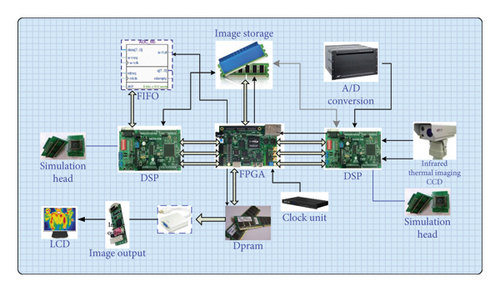
In the system, the two DSP boards carry out 8 bit BT.636 video stream transmission through FPAG|. The infrared thermal imager continuously collects images, and the collected image information is preprocessed by the DSP on the right, and then to the FPAG for identification, and then the data is captured and transmitted to the display.
The infrared thermal imaging camera used in this article does not have too many optical and mechanical scanning structures, weighs about 2 kg, and adopts a high-speed IEEE1392 interface, which is more suitable for different links. The main components of the instrument are: optical system, infrared detector, signal processing, and other parts.
What DSP uses in the system is STM32F051C4, what FPAG uses is XC7K410T, their performance parameters are shown in Table 3.
| STM32F051C4 | |
|---|---|
| Storage (kB) | FLASH:16; RAM:4 |
| Working frequency (MHz) | 48 |
| Timer | 16 bit:8; 32 bit:1 |
| A/d, D/A transformation | 1 × 12 bit |
| Communication interface | 1 × SPI/I2S; 1 × I2C; |
| 1 × USART; 1 × CEC | |
| XC7K410 T | |
| Number of logical units | 406720 |
| I/O | 500 |
| GTX | 8 |
| Serial speed | 600 Mb/s-6.6 Gb/s-28.05 Gb/s |
The connection scheme software program setting of this article uses the video capture and display driver based on the RF5 framework for programming. It mainly implements storage, thread, model, and channel encapsulation.
The advantages of this intelligent system are as follows: (1) Multi-CPU parallel processing: The architecture design of three high-performance CPUs greatly improves the real-time parallel processing capability of the system. (2) Stable and reliable system interconnection: The interconnection between systems is closely linked and the layout is reasonable. It improves the reliability and performance of the working system and has strong anti-interference ability. (3) High recognition and tracking efficiency: Through image data fusion, it improves the system's recognition probability and tracking accuracy. (4) Online editable function: It makes the system flexible and maximizes the use of system functions.
3.2. Target Recognition and Tracking Algorithm
3.2.1. SVM Classifier Target Recognition Analysis
- (A)
Sample selection: Choose different posture images of vehicles and people as training samples and perform wavelet compression after denoising.
- (B)
Perform HOG and SIF feature extraction, that is, image gradient histogram feature and scale-invariant feature extraction.
- (C)
Train the training data with a suitable kernel function model and solve the optimal decision function.
- (D)
Input the test sample into the classifier test to check the correct rate of the classifier.
(1)Evaluation Cost Analysis. This paper selects 4 different infrared targets to test the objective cost optimization effect of the improved SVM algorithm in this paper. The overall objective cost standard deviation of the algorithm in this paper and other SVM classifiers is calculated, and the results are shown in Figure 7. The results show that the optimized SVM algorithm used in this paper has obvious cost advantages. From the data point of view, the overall objective cost results of the algorithm in this paper are better in the process of identifying the four groups of infrared targets. The values are 11.3, 2.05, 15.84, and 3.18.
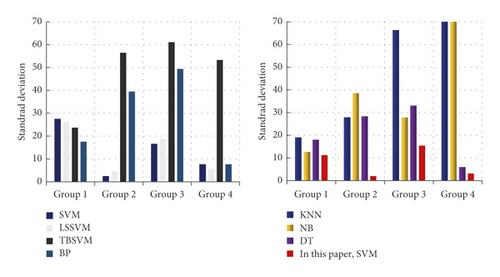
(2)SVM Sample Error Rate Analysis. In the previous part, it has been tested through experiments that the total objective cost of the algorithm in this paper is the smallest among other similar types. Then, in order to verify whether the improved algorithm of this paper can be optimized in terms of the number of wrong samples for classification, the sample error rate of this classifier is compared with other similar classifiers. The compared algorithms include unoptimized SVM algorithm, LSSVM (Least Square SVM) least square vector machine, TBSVM twin bounded support vector machine, BP algorithm-Error Back Propagation (BP) algorithm, KNN minimum neighbor, NB Naive Bayes algorithm (NB algorithm---Naive Bayes), and DT dense trajectory algorithm.
The result is shown in Figure 8. In Figure 8, the objective cost of the classifier is divided into ten scales from 0-1. Obviously, when testing in different sample data sets, the sample error of the optimized SVM algorithm in this paper is the lowest. It can significantly improve the misclassification of samples.
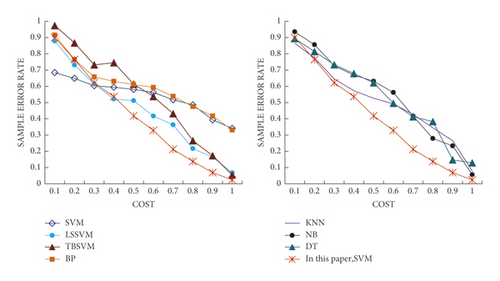
3.2.2. Analysis of Location Tracking Algorithm
In this paper, a fusion filter tracking system is designed based on PF and KCF trackers. The system is mainly composed of a PF module, KCF module, and dynamic update module. Using the PF algorithm to predict the target location, implement target tracking, KCF online learning, and train the image foreground and background. The module is dynamically updated to solve the problem of missing objects due to occlusion and size changes. In this link, this article takes the average distance accuracy, normalized average overlap accuracy and average processing speed as indicators. The fusion filtering algorithm has been tested and compared with the KCF algorithm, DSST algorithm, tracking-learning-detection algorithm (TLD), and PF algorithm, and the result is shown in Figure 9. According to the experimental results, the frame processing speed of the fusion filter tracking algorithm in this paper is 15.32FPS. It meets real-time requirements. At the same time, the best results have been achieved in the two indicators of average distance accuracy and overlap accuracy.
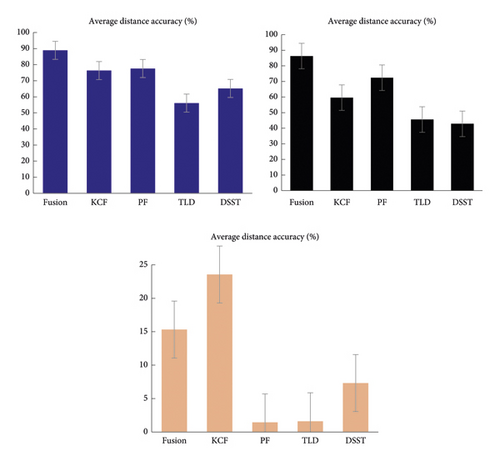
3.2.3. Temperature Error and Transmission Delay Test
Loss of other information about system operation or information error will also affect the effect of system operation. Therefore, this article also conducted a temperature error test, and the test results are shown in Figure 10. The temperature error is obtained by comparing with the temperature measurement value of the alcohol thermometer. A stopwatch is used to estimate the temperature change to test the digital signal transmission delay. Among them, the parameter design requirements of this experiment are as follows: the transmission delay is less than 8 s, and the temperature error is less than 1.5 degrees Celsius. It can be seen from the figure that this system has strong real-time performance and high accuracy. Moreover, when testing, the thermal infrared sensor can quickly capture the temperature change.
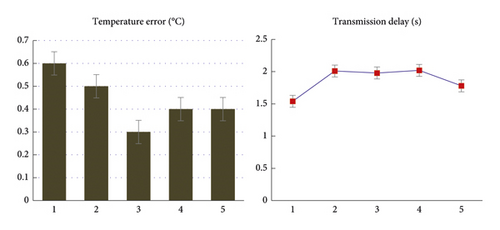
3.3. System Identification and Tracking Results
After repeated debugging and operation, the infrared thermal imaging communication device in this system operates stably and reliably. The experimental results of the dual DSP + FPAG high-performance processor operating architecture are better. The test results show that compared with the dual DSP operating architecture, the improved system in this paper can reduce the system software frame processing time from 120 ms to an average of 28 ms, and the processing speed is increased by about 4.3 times.
4. Discussion
This paper is devoted to designing a communication device architecture of infrared thermal imaging target recognition and tracking system with good processing performance and high real-time transmission. The article first introduces the principle and algorithm of infrared thermal imaging technology in detail. It shows that compared with visible light, infrared imaging has the advantage of working all-weather, but due to its technical characteristics, the recognition rate and robustness of infrared thermal imaging still have certain shortcomings. Second, this article describes in detail several commonly used algorithms for infrared target recognition and tracking, and feature extraction, and presents some current research results. Then, this article introduces the principle of infrared thermal imaging target recognition and tracking system and the composition scheme of infrared thermal imaging dual DSP communication system. In the experiment process of this article, this article designed a FPAG high-performance processor + dual DSP infrared thermal imaging target recognition and tracking communication device system, and based on this, the system algorithm and performance experimental analysis was carried out. This article first tests the classification accuracy of the SVM classifier and compares the optimized SVM classifier in this article with several other SVM classifier algorithms. The results show that the algorithm in this paper is optimal both in terms of objective cost and in terms of identifying sample errors. The second is a comparative test of positioning and tracking algorithms. This paper designs a filter tracking system based on the fusion of PF and KCF. This article also compares the system algorithm with other similar algorithms on the three indicators set (average distance accuracy, normalized average overlap accuracy, and average processing speed). The location tracking algorithm in this paper is still better. Finally, this article tests the temperature error and transmission delay of the communication system, and the results show that the system device can meet the error requirements of real-time transmission.
5. Conclusion
In this paper, an optimized performance infrared thermal imaging target recognition and tracking communication device system is designed. After repeated trials and tests in various environments, the infrared communication device designed in this experiment can work in a more complex environment and has strong real-time performance. The system processing performance has been greatly improved, which has certain practical value. Of course, certain research results are accompanied by certain deficiencies, and there is still a lot of work that needs to be continued. The SVM and HOG feature extraction used in this paper is used for target recognition and tracking. Although it can meet the real-time requirements and has good accuracy and stability, the real-time performance still needs to be improved. Similarly, the infrared communication device system designed in this article has better performance but has more data redundancy and higher memory requirements.
Conflicts of Interest
The author states that this article has no conflicts of interest.
Acknowledgments
This work was supported by the Education Department of Liaoning Province, General project (No. L2014085), and the Major Technology Platforms of Liaoning, China.
Open Research
Data Availability
Data sharing is not applicable to this article as no new data were created or analyzed in this study.




